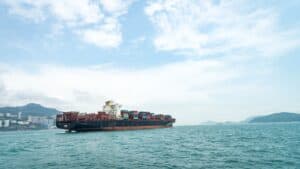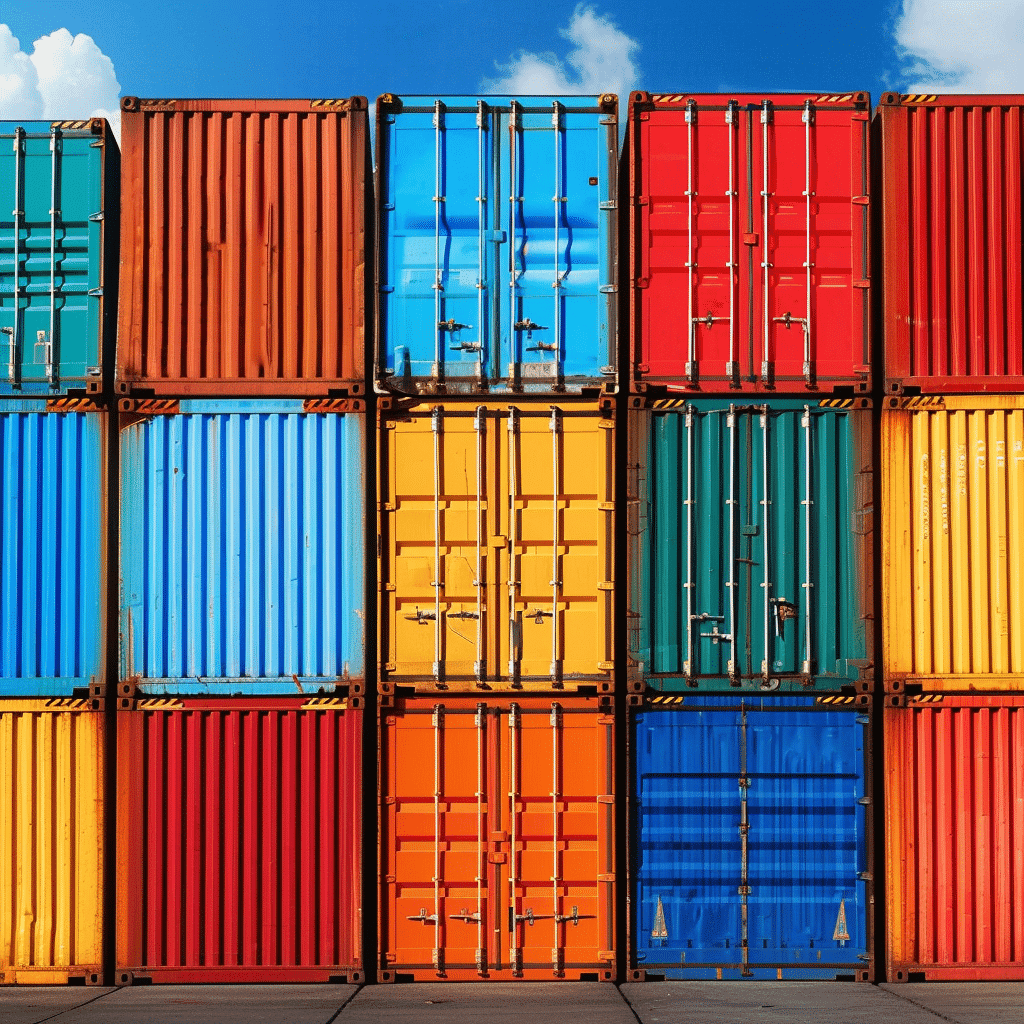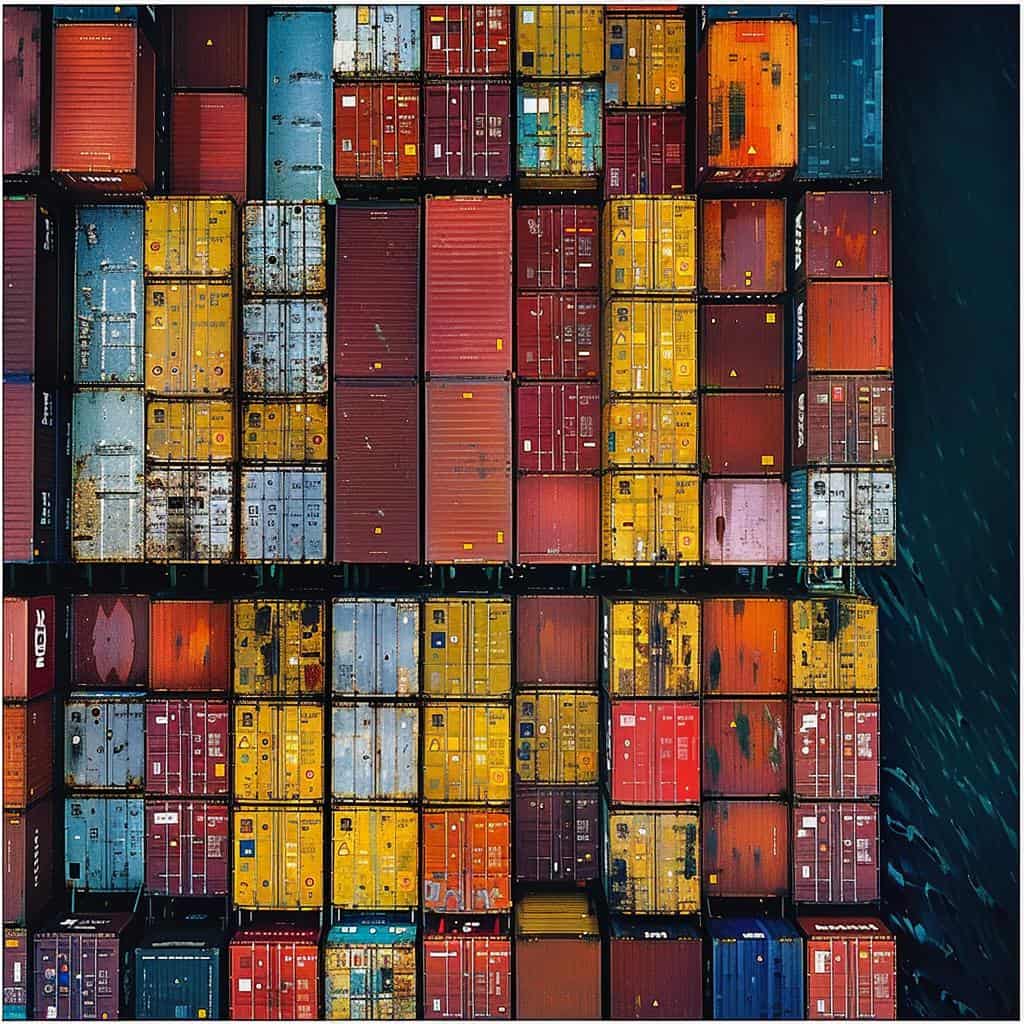Are you wondering how much it’ll cost to ship a container overseas in 2023? Look no further! In this article, we’ll break down the estimated costs of container shipping and help you calculate your own expenses.
Whether you’re shipping internationally or domestically, we’ve got you covered. We’ll also take a closer look at container shipping rates across the world and provide some important considerations for international shipments.
Shipping a container overseas can be an expensive endeavor, as there are various factors that influence the overall cost. The cost to ship a container overseas depends on several key factors such as the size and weight of the container, the distance it needs to travel, and any additional services required.
Container shipping costs can vary greatly depending on these variables. On average, international shipping rates for a standard 20-foot shipping container can range anywhere from $1,000 to $5,000 or more. However, it’s important to note that these are just rough estimates and actual costs may differ based on individual circumstances and market conditions. 40-foot shipping container rates average $1,000- $10,000.
How Much Does It Cost To Ship a Container Overseas in 2023?
To find out the price of sending a container abroad in 2023, you should check with shipping companies or freight forwarders. They can provide you with accurate information about container shipping prices and rates for your overseas move.
The cost of shipping a container internationally can vary depending on several factors such as the size of the container, the destination, and any additional services required. It is essential to gather quotes from different providers to compare prices and choose the most cost-effective option.
Keep in mind that international container shipping rates may also be influenced by market conditions and fuel costs. Therefore, it is crucial to stay up-to-date with current trends in the industry to get an accurate estimate of shipping costs for your specific needs.
Estimate Your Container Shipping Costs
When estimating your container shipping costs, you’ll want to consider factors such as the size of the container, the destination, and any additional services needed.
The cost to ship a container overseas can vary depending on these factors. First, determine the size of the container you need for your shipment. Larger containers generally have higher shipping costs compared to smaller ones.
Next, consider the destination of your shipment. Shipping to remote or less accessible locations may incur higher costs due to transportation challenges.
Additionally, think about any additional services you may require, such as insurance or customs clearance assistance. These services can add to your overall shipping costs.
International vs. Domestic Rates
Comparatively, international rates for shipping are typically higher than domestic rates. When it comes to international moves, shipping companies have various factors to consider when determining the costs of shipping a container overseas.
The cost of shipping a container domestically within the U.S. varies based on the distance and the size of the container. On average, the cost per entire shipping container ranges from $1,000 to $5,000.
For international shipping, the rates are generally higher. The cost to ship a container overseas ranges from $2,500 to $6,000 on average. However, this can go up to $10,000 or more depending on the destination and other factors.
To accurately estimate the costs of shipping a container overseas, it is essential to consult with reputable shipping companies that specialize in international moves. They can provide you with detailed information and help you navigate through the complexities of international shipping while ensuring your goods reach their destination safely and efficiently.
Container Shipping Rates Across the World
International shipping rates vary across different regions of the world, depending on factors like distance, destination, and additional services required. When it comes to container shipping rates across the world, the cost to ship a container overseas can greatly differ based on these factors.
To get an accurate estimate for your specific needs, it is recommended to reach out to a reputable shipping company that specializes in shipping containers overseas. They will be able to provide you with price quotes tailored to your requirements. Additionally, they can assist you in navigating the logistics and paperwork involved in international shipping.
Whether you are importing or exporting goods, finding the right shipping port and understanding the associated costs is crucial when calculating container shipping rates across the world.
Container Sizes and Their Impact on Cost
To accurately estimate the price for your specific needs, it’s recommended that you consider the impact of container sizes on shipping rates. The size of the shipping container you choose can significantly affect the cost of shipping your goods overseas.
Container sizes vary , with standard options from most shipping companies including 20-foot and 40-foot containers. The larger the container, the more it can hold, but also the higher the shipping cost. If you have a smaller shipment or don’t require as much space, opting for a smaller container can help reduce costs.
On the other hand, if you have a large volume of goods to ship, using a bigger container may be more cost-effective in terms of overall transportation expenses. Understanding how different container sizes impact shipping rates is crucial when planning your international shipment.
20ft vs. 40ft Containers
When deciding between 20ft and 40ft containers, consider the specific needs of your shipment. The container size plays a crucial role in determining the overall cost and efficiency of your shipping process.
A 20ft container is suitable for smaller shipments or when you have limited cargo to transport. It is more economical if you don’t require a full container load (FCL).
On the other hand, a 40ft container offers more capacity and is ideal for larger shipments or when you need to transport goods in bulk. If you have a significant amount of cargo or want to avoid multiple containers, opting for a 40ft container would be beneficial.
Both options provide secure and reliable transportation solutions, so choose the one that best suits your shipping requirements.
Key Estimates from Top Cities:
20ft Container Shipping Rates:
- Port of New York (USNYC) to London Gateway Port (GBLGP): $1,804 USD
- Port of New York (USNYC) to Port of Tokyo (JPTYO): $1,444 USD
- Port of New York (USNYC) to Sydney Port (AUSYD): $4,062 USD
- Port of New York (USNYC) to Port of Auckland (NZAKL): $4,860 USD
- Port of New York (USNYC) to Port of Fos Sur Mer (FRFOS): $1,106 USD
40ft Container Shipping Rates:
- Port of New York (USNYC) to London Gateway Port (GBLGP): $2,290 USD
- Port of New York (USNYC) to Port of Tokyo (JPTYO): $2,035 USD
- Port of New York (USNYC) to Sydney Port (AUSYD): $5,157 USD
- Port of New York (USNYC) to Port of Auckland (NZAKL): $6,482 USD
- Port of New York (USNYC) to Port of Fos Sur Mer (FRFOS): $1,459 USD
What Can Fit Inside Different Container Sizes
The 20ft and 40ft containers have different capacities, allowing for various types of cargo to fit inside.
When it comes to container space, the 20ft container can hold up to around 1,170 cubic feet of cargo, while the larger 40ft container can accommodate approximately 2,390 cubic feet.
These dimensions are important to consider when calculating container costs for international container shipping.
If you have a large consignment that fills up the entire container, opting for a full container load (FCL) would be more cost-effective.
On the other hand, if your shipment doesn’t require an entire container, you can choose a less than container load (LCL), which is suitable for smaller loads.
Understanding the capacity and options available for different containers will help you make informed decisions about your own shipping container needs.
Shipping Methods and Their Differences
Now that you have a better understanding of what can fit inside different container sizes, let’s dive into the various shipping methods and their differences.
When it comes to shipping a container overseas, you have two main options: sea freight and air freight. Sea freight is the most common method used for container shipping due to its cost-effectiveness. It involves transporting your goods by ship in containers, which are then loaded onto cargo vessels.
On the other hand, air freight offers faster delivery but at a higher cost. If time is of the essence, this may be the preferred option for you. Additionally, some companies offer door-to-door services where they handle every step of the shipping process from pickup to delivery at your desired location.
Consider these differences when calculating the cost to ship a container overseas in 2023 and choose the method that best suits your needs.
Full-Container Load vs. Less-Than Container Load
Sea freight is the most common method used for container shipping due to its cost-effectiveness. When it comes to sea freight, you have two options: full-container load (FCL) or less-than-container load (LCL).
If you are moving a large volume of goods, FCL is the way to go. With FCL, you rent an entire container exclusively for your shipment. This gives you more control over the packing and reduces the risk of damage during transit.
On the other hand, if your shipment does not fill a whole container, LCL is a suitable choice. However, keep in mind that LCL can come with additional costs since your cargo will be consolidated with other shipments in one container.
It’s also important to note that shipping rates for both FCL and LCL have seen an average rise due to various factors affecting the international move industry.
Modes of Transportation: Road, Sea, and Air
If you’re looking for a quicker option, air freight can be an efficient choice for transporting your goods internationally. Air transport offers fast delivery times but comes at a higher cost compared to sea or road transport. Cargo planes can handle large volumes of freight efficiently and provide reliable transportation services globally.
When considering the cost to ship a container overseas, it’s important to weigh the advantages and disadvantages of different modes of transportation. Sea transport, typically done by cargo ships, is often the most cost-effective option for shipping large volumes of goods. However, it is also the slowest method and may not be suitable if you need your goods delivered urgently.
Road transport is commonly used for domestic shipments or short distances within a country.
Sea Freight
When it comes to shipping large volumes of goods, sea transport is often the most cost-effective option. If you’re looking for a cost-effective way to move your containers internationally, sea freight is the way to go.
The international shipping industry offers port-to-port services that enable you to ship your goods from one port to another. This method allows for efficient and affordable shipment of large quantities of goods.
With sea freight, you can easily transport your containers across long distances at a fraction of the cost compared to air or road transportation. Whether you are sending goods for business purposes or personal reasons, choosing sea freight can help save you money while ensuring timely delivery of your shipments.
Air Freight
For a faster option to transport your goods internationally, consider air freight. Air freight is a convenient and efficient way to ship containers of your belongings overseas. When it comes to the cost of shipping a container overseas, air freight tends to be more expensive compared to sea freight. However, the speed and reliability of air freight can make it worth the extra cost for time-sensitive shipments or valuable items.
Shipping costs for air freight are typically calculated based on factors such as weight, volume, and destination. It’s important to compare quotes from different air freight companies to get the best deal for your international moving costs.
Keep in mind that while air freight may be pricier than sea freight, it offers quicker delivery times and better security for your shipping container.
Factors Influencing Container Shipping Costs
To determine the price of shipping your goods internationally by air, you should consider factors such as weight, volume, and destination.
However, if you are looking to ship a container load overseas via container ships, there are several other factors that affect the cost.
Firstly, the size and weight of your shipping container will play a significant role in determining the expense.
Additionally, the distance to the destination port can also impact the price. Longer distances may require transshipment or additional handling, resulting in higher costs.
Moreover, it is important to factor in any special requirements for shipping container moving, such as refrigeration or hazardous materials.
Lastly, don’t forget about shipping insurance which can provide financial protection in case of unforeseen events during transit.
Distance: Local, Statewide, National, and International
The size and weight of your container will greatly impact the shipping expenses. Whether you are moving domestically, long distance, or internationally, the distance plays a crucial role in determining the cost of shipping a container.
For domestic moves within the same state or nearby states, the expenses might be relatively lower compared to long-distance moves across the country.
International shipments involve additional costs due to customs regulations, import taxes, and documentation requirements. When shipping a container internationally, it’s important to consider whether it will be sent via door to door service, or port to port.
Door-to-door services provide convenience but can be more expensive. On the other hand, choosing port-to-port shipping may require additional transportation arrangements upon arrival at the destination port.
Size of the Shipment: Full vs. Empty Containers
When deciding on the size of your shipment, consider whether you will be using a full or empty container.
The size of the shipment plays a significant role in determining the cost to ship a container overseas. If you have a large quantity of goods to transport, using a full container might be more cost-effective. This option allows you to maximize the space and ensures that your items are secure during transit.
On the other hand, if your shipment is small or does not require an entire container, opting for an empty container can save you money. By sharing the space with other shipments, you can split the cost and reduce expenses and shipping container cost.
Additional Costs: Permits, Fees, Siting, etc
Consider researching the necessary permits, fees, and siting requirements before finalizing your shipment plans.
When shipping a container overseas in 2023, there are several additional costs to take into account.
Customs duties may be imposed by the destination country, which can vary depending on the type of goods being shipped.
Container inspection fees may also apply to ensure compliance with safety regulations.
It is important to factor in insurance costs to protect your shipment against any potential damage or loss during transit.
Quarantine fees might be necessary if certain goods require special handling or treatment upon arrival.
Service charges for handling and transporting the container should also be considered.
Additionally, it is essential to inquire about any additional fees that may arise throughout the shipping process.
Insurance and Its Importance
Make sure you factor in insurance costs to protect your shipment against any potential damage or loss during transit.
When shipping a container overseas, it is crucial to have insurance cover in place to safeguard the monetary value of your goods. An unforeseen accident or mishap during transportation can result in significant financial losses if you do not have adequate insurance coverage.
The cost of insuring a shipping container may vary depending on various factors such as the destination, duration of transit, and the value of the cargo being transported. However, regardless of the cost, having insurance is of utmost importance as it provides peace of mind knowing that you are protected against any potential risks or damages that may occur while your shipment is in transit.
Siting and Equipment Needs
Siting and equipment needs can vary depending on the specific requirements of your shipment. When shipping your belongings overseas, it is essential to consider additional services and special equipment that may be required.
For example, if you are transporting containers internationally, you may need moisture resistant containers to protect your goods from any potential damage caused by humidity or water exposure during transit.
Moreover, certain items may require specialized handling or equipment. Fragile or sensitive goods might need extra care and attention, such as temperature-controlled containers or shock-absorbent packaging materials.
It is crucial to communicate with your shipping provider about the nature of your cargo so that they can recommend the appropriate container and equipment for safe transportation.
Customs Duties, Inspection Fees, and Quarantine Fees
To ensure a smooth process, it’s important to familiarize yourself with the customs duties, inspection fees, and quarantine fees that may be associated with shipping your belongings internationally.
When shipping a container overseas, there are several extra fees you should be aware of. Customs duties are taxes imposed on imported goods and vary depending on the country you are shipping to.
Inspection fees may also apply when your shipment is checked for compliance with regulations. Quarantine fees might be charged if your items need to go through a quarantine process upon arrival in the destination country.
Additionally, you will need a customer identification code to facilitate the customs clearance process. It’s crucial to research and understand these costs before sending your items in a shipping container abroad to avoid any surprises along the way.
Choosing the Right Shipping Company
When choosing the right shipping company, you’ll want to consider factors such as reliability, cost, and track record.
One of the main concerns when shipping a container overseas is how much it will cost. The cost can vary depending on several factors, including the size of the container and the distance it needs to be shipped. It’s important to research different shipping companies and compare their rates to find the most affordable option for your needs.
Additionally, you should also take into account any potential extra costs that may arise during transit, such as fees for bad weather conditions or unexpected delays.
Ultimately, finding the cheapest way to ship your entire container overseas while ensuring a convenient and reliable service should be your goal when selecting a shipping company.
International Shipping Considerations
If you’re considering international shipping, it’s important to research different shipping companies and compare their rates.
When it comes to moving your household goods overseas, there are several key considerations to keep in mind.
First and foremost, you need to determine the size of the shipping container that will be needed to transport your items. This will depend on the volume of goods you plan to move.
Additionally, you should consider the distance and destination of your move, as these factors can greatly impact your overall moving costs.
It’s also crucial to ensure that the shipping company you choose has experience with overseas shipping and understands any specific requirements or regulations for transporting items internationally.
Moving Containers Across Different Distances
Moving containers across different distances can be challenging, but it’s important to consider factors like the size of the container and the distance of your move.
When choosing a moving container for your short distance move, it’s crucial to think about the available floor space. You want to make sure that you maximize space and all your belongings will fit comfortably in the container without any damage during transit.
Another aspect to keep in mind is the cost of inland delivery charges. Depending on how far you are moving, these charges can vary greatly and impact your overall budget.
Additionally, if you require storage for your belongings before or after the move, some moving container companies offer convenient storage options at an additional cost.
To make transportation easier, consider renting a moving truck alongside your container for a seamless move from start to finish.
Costs of Different Container Sizes and Types
It’s important to consider the size and type of container you need for your move, as this will directly impact the overall cost.
When it comes to shipping containers, there are different sizes available ranging from 20-foot transport containers to 40-foot containers. The size you choose will depend on the volume of your belongings.
Additionally, there are two main types of containers: full container load (FCL) and less than container load (LCL) shipments. If you have enough items to fill a whole container, FCL is the way to go, as it offers more flexibility and security. On the other hand, if you have smaller quantities or don’t mind sharing space with other cargo, LCL shipments can be a cost-effective option.
Shipping containers can be accessed in ports like Long Beach and Los Angeles when moving within one country or internationally.
FAQ:
How Much Does It Cost To Ship a 40-Foot Container?
The cost to ship a 40ft container varies based on several factors, including the route, origin port destination, and shipping company. On average, it can range from $2,000 to $3,000.
How Much Does It Cost To Ship a Full Container?
Shipping a full container typically costs between $2,000 and $3,000, but this can vary depending on factors like the size and weight of the container, the vendor, and the shipping route.
How Much Does It Cost To Ship a 40-Foot Container From China to the USA?
The average cost to ship a 40-foot container from China to the USA can range from $2,000 to $3,000, but this is a general estimate and can vary based on specific factors like the shipping company, season, and other surcharges.
How Do I Ship a Container Internationally?
Shipping a container internationally involves transporting goods to different countries in containers via land and sea. The process includes selecting a freight forwarder, organizing the necessary documents (such as Commercial Invoice, Bill of Lading, Export Packing List, and Certificate of Origin), and understanding potential surcharges like demurrage and detention. It’s essential to work with a customs broker to ensure compliance with international trade regulations and track shipments to ensure timely delivery.
Conclusion
So there you have it, shipping a container overseas in 2023 can vary greatly depending on several factors.
Like we mentioned, a 20-foot shipping container can range anywhere from $1,000 to $5,000 or more. 40-foot shipping container rates average $1,000- $10,000.
It’s important to estimate your container shipping costs and consider the differences between international and domestic rates.
Container shipping rates also vary across different parts of the world, so it’s crucial to take that into account as well.
Additionally, the distance you’re moving your container will impact the cost.
Lastly, don’t forget to factor in the costs associated with different container sizes and types.




